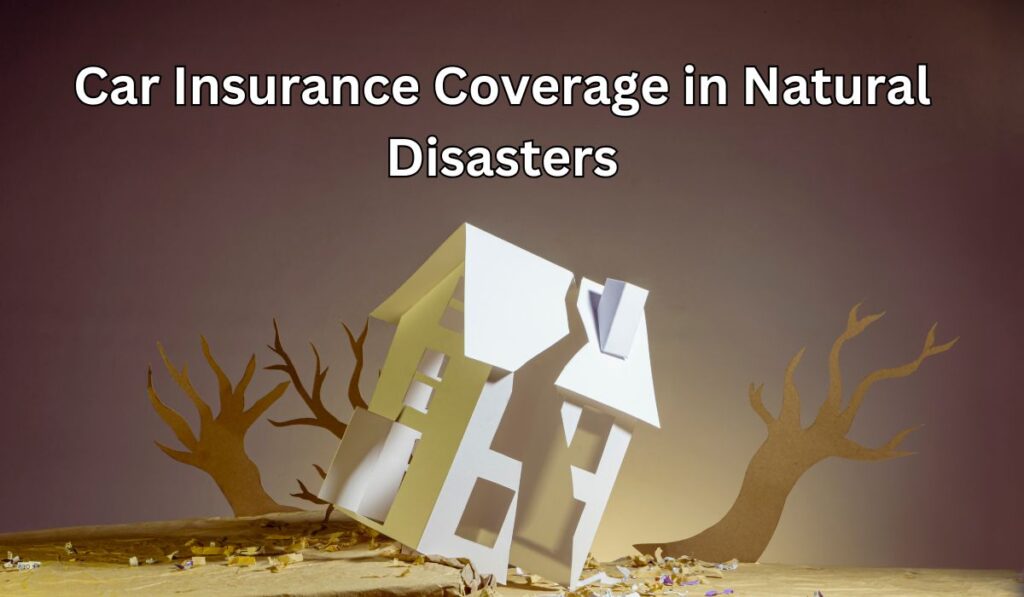Natural disasters like floods and hurricanes are hitting the US hard. In 2020, 2021, and 2022, the damage was huge. It’s key to know how car insurance helps in these times. With the right coverage, you can keep your car safe from unexpected disasters.
Do you have the right insurance for your car in natural disasters? Floods, hurricanes, and other disasters can really damage your vehicle. It’s important to have the right coverage to protect your car.
Comprehensive coverage is a must in areas prone to floods, like Texas and Florida. These places have seen a lot of damage from disasters. Car insurance can help cover costs from storms, hurricanes, and more. It’s the difference between paying for repairs or losing money.
Knowing your car insurance coverage in natural disasters is vital. It ensures you’re protected from the damage these disasters can cause.
The Basics of Car Insurance Coverage in Natural Disasters
Protecting your vehicle from natural disasters requires the right car insurance. You need hurricane, flood, and earthquake auto insurance. These are key parts of a full policy. Without them, your vehicle might not be covered for damage from natural disasters.
In places where disasters are common, getting the right coverage is smart. For example, hurricanes and tropical storms are usually covered. Flood insurance is vital for areas at risk of flooding. And if you live where earthquakes happen, you need earthquake auto insurance.
Understanding Comprehensive Coverage
Comprehensive coverage is optional but very important. It includes collision, and liability coverage. The cost is about $184.14 a year, with a $500 deductible. Make sure you know what your policy covers and what it doesn’t.
Policy Limitations and Exclusions
Some policies don’t cover certain disasters like floods or earthquakes. Always check your policy for what’s not covered. Having the right insurance, like for hurricanes, floods, and earthquakes, protects your vehicle from unexpected damage.
Hurricane and Flood Protection for Vehicles
Comprehensive car insurance is key to protect vehicles from hurricane damage. You might need a hurricane protection rider for extra coverage. Flood insurance is also vital, as floods can happen from heavy rains, overflowing rivers, or storm surges.
It’s important to know that hurricane car insurance can have different terms and exclusions. Water damage from hurricanes might be seen as flooding, which could not be covered. So, check your coverage details and the insurance company’s reputation before a storm hits.
Comprehensive coverage is optional but often needed by lenders if you’re financing or leasing a vehicle. This coverage includes damage from weather like flooding, heavy rains, and hail. But, it doesn’t cover water damage to things you installed yourself, like stereos or GPS devices. Having flood insurance and hurricane car insurance helps protect your vehicle from natural disasters.
Insurance companies might not let you change policies or add new coverage before a big storm. After a major disaster, claims can take a while to process because of all the claims coming in. Reading customer reviews can help you see how well an insurance company handles claims after a storm. Knowing the value of both flood insurance and hurricane car insurance helps you make smart choices to protect your vehicle from disasters.
Understanding Fire and Wildfire Coverage
Fire insurance for cars is key to protecting vehicles from fires. It’s vital for those living in wildfire-prone areas. Wildfires can severely damage cars.
Forest Fire Protection
Comprehensive coverage often includes damage from wildfires. It’s important for drivers in wildfire areas. Wildfires can damage cars directly or through smoke, which is expensive to fix.
Garage Fire Coverage
Fire insurance also covers garage fires. It’s critical for those who park in garages. Garage fires can badly damage cars.
Fire-Related Damage Assessment
Insurance companies look at damage extent and policy terms when assessing fire damage. Drivers with full coverage can claim for repairs or a new car, based on damage severity.
Tornado and Wind Damage Insurance Considerations
Every year, about 1,200 tornadoes hit the United States, causing a lot of damage to cars. Tornado winds can go up to 300 miles per hour, leading to severe damage or even total loss. It’s important to have comprehensive vehicle coverage to protect against natural disasters like tornadoes. This coverage usually includes damages from natural disasters, fire, theft, and more.
Having tornado damage coverage can give you financial security and peace of mind. Make sure to check your insurance policy to see if you have enough coverage. Also, hail storm car coverage is useful because wind and hail damage are common reasons for claims. Knowing your insurance options and having the right coverage can help protect your car from tornadoes and other disasters.
After a natural disaster, insurance companies deal with many claims at once. Filing your claim quickly can help speed up the process of fixing your car. Being prepared and having a plan can make the claims process smoother.
Hail and Storm Damage Protection
Comprehensive insurance is key for protecting cars from hail and other disasters. Hailstorms can cause a lot of damage, even without hurricanes. Hail can be as big as a baseball, leading to expensive repairs. Claims for natural disasters usually have a deductible between $250 and $1,000.
Comprehensive coverage is a must for car insurance, along with liability and collision. It’s needed for leased or financed vehicles. Also, cars worth over $3,000 in flood zones need it to protect against flooding. Hail coverage is a big part of this, helping to lessen the cost of hail damage.
Importance of Comprehensive Coverage
Comprehensive coverage is the main type for storm damage to cars. It’s not in homeowners or flood insurance. The deductible is what you pay first before insurance kicks in. Some insurers have different deductibles for windshield damage.
With this insurance, car owners can be sure they’re safe from hail and other disasters.
Earthquake Coverage and Regional Considerations
Earthquakes can seriously damage cars. It’s key to have the right insurance. Earthquake auto insurance helps protect your vehicle financially. The United States Geological Survey (USGS) says 42 states are at risk of earthquake damage.
Comprehensive coverage might include earthquake damage. It’s important to check your policy. Deductibles for earthquake insurance are usually 2% to 20% of your property’s value. There are two separate deductibles for coverage.
In places like California, earthquake auto insurance is very important. California has seen some of the most expensive earthquakes. Only 10% of Californians have earthquake insurance. The New Madrid Seismic Zone also faces a high risk of earthquakes.
| State | Earthquake Risk | Percentage of Residents with Earthquake Insurance |
|---|---|---|
| California | High | 10% |
| Washington | Medium | 11.3% (in 2017) |
| Missouri (New Madrid region) | High | 11.4% (in 2021) |
In summary, earthquake auto insurance is vital for protecting your car. Knowing the risks and coverage options helps you make smart choices.
How to Assess Your Current Insurance Policy
Understanding your car insurance policy is key, when it comes to natural disasters. Insurance for disasters can protect your finances from damage. Start by checking your policy for any gaps or limits.
Doing a coverage gap analysis is a good first step. Think about the disasters common in your area. Make sure your policy covers them well. For example, if floods are common, your policy should cover flood damage.
Here are some important points to consider when reviewing your policy:
| Type of Coverage | Description |
|---|---|
| Comprehensive Coverage | Covers damages from natural disasters, such as floods, hurricanes, and wildfires |
| Collision Coverage | Covers damages from accidents, regardless of fault |
| Liability Coverage | Covers damages to others in an accident, including medical and repair bills |
By understanding your policy and its gaps, you can ensure you’re covered. Having the right insurance for disasters gives you peace of mind. Always review and update your policy as needed.
Steps to File a Natural Disaster Claim
When a natural disaster hits, it’s key to talk to your insurance company right away. This starts the claims process for your car insurance. Acting quickly makes the process smoother and more efficient.
It’s important to document the damage to your vehicle. Take photos or videos of the damage. Then, share them with your insurance provider to support your claim. This helps them assess and process your claim faster.
Filing a claim for car insurance after a natural disaster involves a few steps. First, call your insurance provider to report the damage. Then, give them detailed photos and videos of the damage. They will guide you on what to do next, which might include inspecting your vehicle and assessing the damage.
| Step | Description |
|---|---|
| 1. Contact Insurance Provider | Report the damage and initiate the claims process |
| 2. Document Damage | Take photos or videos of the damage to support your claim |
| 3. Provide Documentation | Submit photos, videos, and other relevant documents to your insurance provider |
By following these steps and working closely with your insurance provider, you can ensure a successful claims process. This makes filing storm damage claims efficient and effective.
Cost Factors and Premium Considerations
Understanding the cost of car insurance in natural disasters is key. Premiums change based on where you live and the coverage you choose. For example, drivers in disaster-prone areas might pay more for full coverage.
How risky an area is affects insurance costs. Places at high risk for disasters, like floods or hurricanes, have higher premiums. Also, the deductible you pick can change your premium. A higher deductible means lower premiums but think about what you’ll pay if you need to file a claim.
| State | Average Annual Premium |
|---|---|
| California | $1,453 |
| Florida | $5,533 |
| Texas | $3,726 |
Knowing these factors helps drivers choose the right insurance. This includes full coverage for disasters. It can help you save money on your premiums.
Preparing Your Vehicle for Natural Disasters
Preparing your car for natural disasters is essential. While insurance offers financial protection, practical steps can make a big difference. These steps help protect your vehicle when extreme weather hits.
Start by putting together an emergency kit with important items. Also, park your car in a secure garage to prevent damage. Documenting your car’s condition before a disaster can also help with claims.
Focus on car insurance coverage in natural disasters and extreme weather car insurance protection. This way, you can drive with confidence, knowing your car is safe. With the right preparation and insurance, you’ll be ready for any storm.

